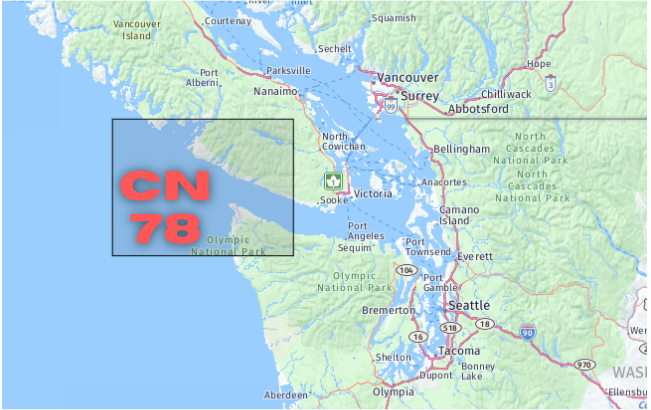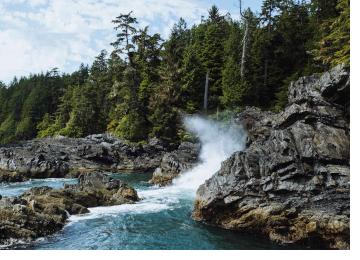
 These DXpeditions are a passion project led by #TeamTopLeft to help other radio amateurs log contacts to maidenhead grid square CN78, a sparsely populated destination in the Pacific Northwest.
These DXpeditions are a passion project led by #TeamTopLeft to help other radio amateurs log contacts to maidenhead grid square CN78, a sparsely populated destination in the Pacific Northwest.
CN78 has the distinction of being the furthest top left grid of the continental United States. It is also a rare grid for anyone chasing the Fred Fish Memorial Award (FFMA) by confirming 6M QSOs with all 488 grid squares that include any part of the continental United States.
Several years ago, Barry Hansen (K7BWH) and Rod Johnson (WE7X) took a 650 mile trip across the Olympic Peninsula to active CN78 and detailed their trip in an article for ARRL’s QST Magazine. Their goal was to activate the remote lowland coastal grids of the peninsula during the VHF contest in the dead of winter. Barry called CN78 “the single most difficult grid square” of the trip. You can read their story here.
Grid CN78 spans the Strait of Juan de Fuca that separates the Olympic Peninsula in Washington State from the west coast of Vancouver Island in British Columbia.
On the Northwest tip of CN78 lies Ucluelet (pop 1,717), a resort destination at the western edge of Barkley Sound, 288 km (179 mi) northwest of the British Columbia provincial capital, Victoria. Ucluelet means “people of the safe harbour” in the Nuu-chah-nulth (Nootka) language. In 1870, fur sealers came to the area seeking ports for vessels working the Bering Sea sealing grounds and established a trading post in Ucluelet harbour. Now, Ucluelet is a hotspot for storm watching, fishing, and outdoor activities.
South along the coast is the Pacific Rim National Park Reserve. The park is an important link in the 75 km (47 mi) West Coast Trail, part of the ancient paths and paddling routes used for trade and travel long before Europeans arrived on Vancouver Island. As the years passed and the number of ships sailing the Juan de Fuca Strait increased, so too did the number of shipwrecks and drownings along the coast. In time, the coastline became known as “the Graveyard of the Pacific.” Once settlers arrived, they turned the roads into trails to assist with recovering shipwrecked sailors.
Now, the West Coast Trail is an iconic backcountry, multi-day backpacking trail that is a bucket list challenge for many hikers. Hikers climb more than 100 ladders with a heavy pack, trudge through deep mud, wade through mountain-fed rivers in fast-flowing hip-deep waters, and push through whatever weather the wild West Coast delivers — often driving wind and rain.

South of Pacific Rim Park is Port Renfrew (pop. 144), known as the “Tall Tree Capital of Canada.” Just east is Juan de Fuca Provincial Park that protects a highly scenic and unique shoreline area of the Salish Sea. The park provides a protected habitat and natural corridor for many larger species of west coast mammals such as cougar, deer, black bear, wolf, otter, seal and sea lions. Red, purple and orange starfish and sea urchins, white gooseneck barnacles, blue mussels and green sea anemones and sea cucumbers only begin to hint at the colourful spectrum of intertidal life thriving here.
On the eastern edge of the grid is the town of Lake Cowichan (pop. 2,974), located on the east end of the similarly named Cowichan Lake, which claims to be British Columbia’s “second-most pristine lake.” The unsurprisingly named Cowichan River flows through the middle of the town and is filled with people gently floating on rubber tubes in the summer. The town is best known for being the western end of the Trans Canada Trail, which, when completed, will be one of the longest trail networks in the world at almost 24,000 km (15,000 mi) length.
Lake Cowichan is surrounded on all sides by the Pacific Northwest Temperate rainforest, containing the largest, tallest, and oldest trees in the world outside of California. This ecosystem also has the warmest climate in Canada.
In Washington, settlement on the Northwest tip of the Olympic Peninsula was originally spurred by industries like fishing and logging. Sekiu (pop. 27) was first settled in 1879 by J.A. Martin who attempted to establish a salmon cannery there. Now, Neah Bay is the largest community in the area, with a population of 865. The town is located on the reserve land of the Makah Native Americans. The name “Neah” refers to the Makah Chief Dee-ah, pronounced Neah in the Klallam language. During the summer months, Neah Bay is popular with sports fishermen. Another attraction is the Makah Museum, which houses artifacts from a Makah village partly buried by a mudslide around 1750.
